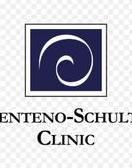The low back pain and spinal curve started gradually. Over time it has progressed such that the pain is now constant and you tilt to one side. Conservative care, medications, and steroids have not helped. Your doctor thinks that you have scoliosis. What is Degenerative Scoliosis? How is it diagnosed? What are the symptoms of Degenerative Scoliosis? How is it measured? Can Degenerative Scoliosis be reversed? What are the treatment options? Are there new non-surgical treatment options? What is a Percutaneous Scolioplasty? Let’s dig in.
What Is Degenerative Scoliosis?(Curved Spine) 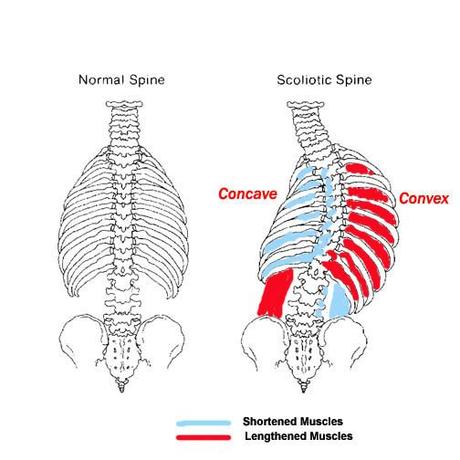
Degenerative Scoliosis, also known as Adult-onset Scoliosis, is a medical condition that involves a side bending in the spine. The bending can be mild, moderate, or severe with side-bending to either the right or the left. The term degenerative means generalized wear and tear and is common as we get older. Degenerative scoliosis is the curvature of the spine that occurs as a result of degeneration of the discs, small joints, and building blocks. The Degenerative Scoliosis curve is often located in the low back and forms a ‘C” shape. There is a convex and a concave side. The convex side is the open side where it curves outward. The concave side is opposite the convex side, is smaller, and curves inward.
Degenerative Scoliosis is not to be confused with adolescent scoliosis commonly seen in adolescents during a growth spurt. This is called Adolescent Idiopathic Scoliosis (1).
How Is Degenerative Scoliosis Diagnosed?
The first step is a complete evaluation by your physician that includes a review of past medical history, trauma, past surgical history, and a list of current medications. A physical examination is essential. Your doctor will examine your posture, walk, symmetry of shoulders and hips along with your ability to bend forward, backward, and twist. Muscle strength and size will be evaluated. Radiographic tests that may be ordered include a full body x-ray, MRI, or CT scan.
What Are the Symptoms of Degenerative Scoliosis? (Pain)
Symptoms, pain, and limitations are dependent upon the duration and severity of Degenerative Scoliosis (2). Some patients may experience no symptoms. In some mild cases, the symptoms are similar to lumbar degenerative disc disease. What is different in Degenerative Scoliosis is that the patients typically report different types of pain on either side of the spinal curve. Some have pain only on one side of the spine whereas others have it on both sides. On the compressed side, the concave side of the spinal curve common symptoms include:
- Deep, unrelenting pain in the mid and low back
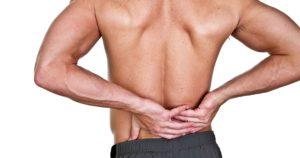
- Electrical, shearing pain in the low back, buttock that radiates down the leg (sciatica)
- Tingling and pins and needles in one leg
- Mid and low back persistent muscle spasms and weakness
The convex side of the spinal curve has the curve that opens up. Muscles, tendons, and ligaments on the convex side are stretched due to the spinal opening up on this side of the spine. Common symptoms include:
- Persistent muscle tightness that does not respond to conservative treatment
- Enlarged muscles on this side of the spine as they are constantly being pulled
Symptoms are not acute and progress gradually over time. They are typically worse first thing in the morning and improve with activity and as the day progresses.
Measuring Scoliosis Severity: The Cobb Angle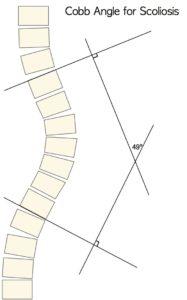

The Cobb angle is a measure of the curvature of the spine. It is the most widely used measurement to quantify the magnitude of spinal deformities. It is measured in degrees. Scoliosis is defined as a lateral spinal curvature with a Cobb angle of >10° (3)
How is the Cobb angle measured? As shown here, this is the angle formed between lines drawn parallel to the vertebra at the beginning and end of the curve. The treatment type chosen for the Scoliosis patient is often determined by this angle:
- Scoliosis-specific exercises (15 – 25° Cobb)
- Bracing (20 – 40° Cobb)
- Spinal fusion surgery (> 40 – 50° Cobb)
For smaller curves exercise therapy is often prescribed. For medium curves measuring between 20-40 degrees bracing is used. Finally, in severe curves measuring in excess of 40 degrees, spinal fusion surgery is often utilized. As discussed later in the post, we have a new treatment option involving Interventional Orthobiologics that may make surgery less common.
Can Degenerative Scoliosis Be Reversed?
The short answer is no. The severity of Scoliosis will determine the appropriate course of action. Certain types of injections discussed below may slow the progression of Scoliosis. Once the curve in the spine has started the only way to try to straighten the spine would be by using fusion surgery with long rods. However, straightening a young spine where the bones have yet to change shape is easier. In Degenerative Scoliosis, the shape of the bones has already changed, so there is really no practical way to straighten the spine, even with surgical fusion.
What Is the Treatment for Degenerative Scoliosis? (Conservative Care, Injections and Surgery)
Treatment for Degenerative Scoliosis will depend upon the severity of the spinal curve, symptoms, underlying medical conditions, and one’s overall level of functioning. When appropriate conservative care should always be first-line treatment. The three principal treatment options include:
Conservative Care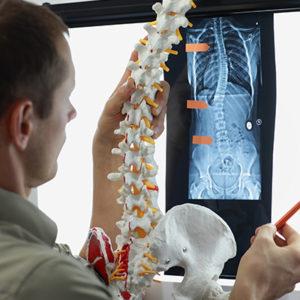

Treatment options include physical therapy, massage, dry needling, stretching, chiropractic care, and targeted exercise. Exercises are can be effective in the treatment of some cases of Degenerative Scoliosis. The most popular physical therapy to avoid scoliosis surgery is the Schroth method which was founded in the 1920s. This involves pelvic corrections, right angular breathing, and stretching/strengthening to stabilize and correct the spine (4). High-quality studies have shown that this can be effective long-term in reducing the Cobb angle (5). In addition, long-term follow-up studies have shown that AIS patients treated with either bracing or surgery had little difference in the quality of life (6).
Traditional Pain Injections
High-dose steroid epidural injections are commonly used for patients with Degenerative Scoliosis. The procedure is performed at a pain clinic or ambulatory surgery center. The goal is to reduce the inflammation and irritation of the spine and exiting nerves. Facet joint steroid injections are also used with the goal of reducing the inflammation and pain in the facet joint. Facet joints are small paired joints on the backside of the spine that provides stability and limits rotation. In Degenerative Scoliosis, they can be injured or irritated as a result of the curve in the spine. While steroids are very effective anti-inflammatory agents they cause extensive damage to orthopedic tissue. The very steroids that are injected into the epidural space and facets have been demonstrated to be toxic to muscles, tendons, and ligaments and destroy cartilage (7).
Surgery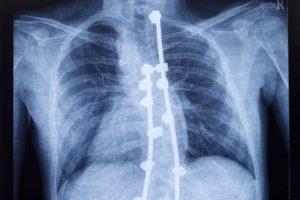

Surgery treatment typically involves multi-level fusion. Fusion is a surgical procedure where one or more of the spinal building blocks (vertebral bodies) are joined together, straightened, and stabilized by screws, bolts, and rods. Degenerative Scoliosis surgery is a major surgery requiring many hours and extensive rehabilitation. There are significant risks that include bleeding, infection, failure, escalation in pain, nerve damage, failed fusion, Complex Regional Pain Syndrome (CRPS). In addition, patients are at risk for additional degeneration of the discs, facet, and ligaments above and below the fusion. This is called Adjacent Segment Disease. To learn more about this significant complication please click on the video below.
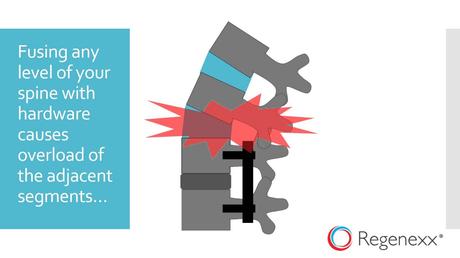
A New, Non-surgical Approach to Treating Degenerative Scoliosis
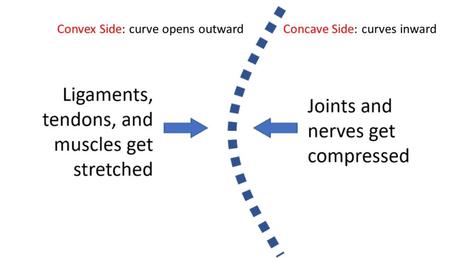
When the spine side bends, there is one side that’s compressed and one side that gets stretched. Hence, on the side of the compression (the concave side), the joints and holes for the nerves (foramina) get extra forces which cause the joints to become big and arthritic and the spinal nerves to become irritated leading to sciatica. On the side of the stretching (convex side), the tendons, ligaments and muscles get pulled on which leads to them getting beat up.
While the traditional pain management approaches above focus on finding one thing that’s causing pain, in Degenerative Scoliosis, it’s often many things that are causing pain. Hence, we developed a procedure that uses precise Orthobiologic injections into many structures. The procedure is called a Percutaneous Scolioplasty. So on the side of the concavity, we’re injecting into many facet joints and nerve areas that are getting compressed and on the side of the convexity, we’re injecting into all of those beat-up tendons and ligaments. Orthobiologics are things like platelet-rich plasma or bone marrow concentrate which contains stem cells that may help these areas heal. The goal of using precise Orthobiologic injections is to:
- Tighten and strengthen tissues that are under stress due to a curve in the spine
- Reduce deformity and provide additional resistance to further collapse
- Reduce irritation of spinal nerves, small joints, tendons, and ligaments on the convex side of the curve
- Reduce the pain and dysfunction originating from areas of tendon injury on the concave side of the curve
- Improve the ability of the multifidus to stabilize the spine
Functional Degenerative Scoliosis Treatment
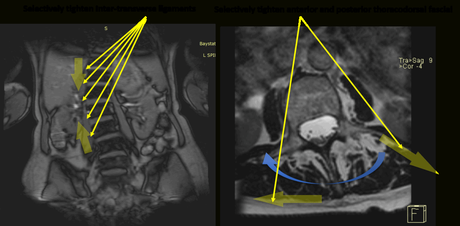
The problem with Scoliosis is that the farther its side is bent off-center, the more it wants to move in that direction. So while helping areas that hurt is great, what if we could buttress the ligaments and fascia in a precise way to provide support for the scoliosis? That’s the second part of this new procedure. These same Orthobiologics can be used in a precise injection to target and tighten the ligaments and fascia.
For example, the above image on the left is an MRI of the lumbar spine that mildly bends to the left. It is a frontal image (coronal). There are important ligaments between the spinal building blocks called Inter-Transverse Ligaments. In degenerative scoliosis, these ligaments are stretched on the convex side (the side with the curve that opens up). These ligaments can be injected under x-ray or ultrasound guidance. The goal of the injection is to tighten the stretched Interspinous Ligaments thereby limiting the progressive spinal curve and associated symptoms.
The above image on the right is a side cut of the lumbar spine otherwise known as an axial image. The large boney prominence that you can feel when you touch someone’s back is rotated to the right. This is consistent with Degenerative Scoliosis as when the spine side bends it also rotates. In this case, the supporting fascia and ligaments can be injected to reduce the spine’s rotation. A key supporting structure is which is identified by the blue arrows is the Thoracolumbar Fascia. It is treated with PRP or bone marrow concentrate which contains stem cells in an effort to restore spinal alignment.
To learn more about Percutaneous Scolioplasty, see the video below:
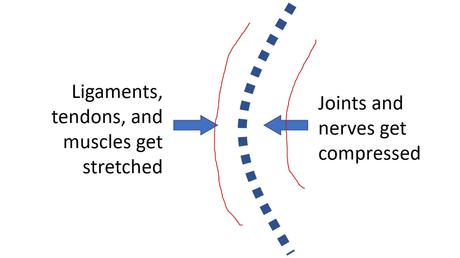
In Conclusion
- Degenerative Scoliosis, also known as Adult-onset Scoliosis, is a medical condition that involves a side bending in the spine.
- One side of the spine curve is open and is called the convex side. Directly opposite the convex side, the spinal curve turns inward which is called the concave side. The result is a C shaped curve.
- Degenerative Scoliosis is not to be confused with Adolescent Scoliosis.
- Degenerative Scoliosis is diagnosed by physical examination, review of medical history, and radiographic studies.
- Symptoms vary depending upon the duration and severity of Degenerative Scoliosis.
- Symptoms may involve one side of the spine or both,
- The Cobb angle is a measure of the curvature of the spine. It is measured in degrees.
- Degenerative Scoliosis can be successfully managed but not reversed.
- Treatment options include conservative care, traditional pain injections, and surgery.
- Degenerative Scoliosis surgery is major surgery with extensive rehabilitation and a list of complications including failure.
- Percutaneous Scolioplasty is a nonsurgical treatment option utilized exclusively at the Centeno-Schultz Clinic where PRP and bone marrow stem cells are injected in areas of damage to decompress the overloaded, injured tissue and improve symmetrical stability.
If you or a loved one has Degenerative Scoliosis with pain and limitations please schedule a telephone candidacy discussion with a board-certified, fellowship-trained physician. From the comfort of your home, office or beach cottage learn what treatment options are available for you. Call today and stop the pain, misery, and suffering. Act now before you become dependent upon medications or you find yourself in a surgeon’s office desperate for relief.
1.Bettany-Saltikov J, Turnbull D, Ng SY, Webb R. Management of Spinal Deformities and Evidence of Treatment Effectiveness. Open Orthop J. 2017;11:1521–1547. Published 2017 Dec 29. doi:10.2174/1874325001711011521
2.York PJ, Kim HJ. Degenerative Scoliosis. Curr Rev Musculoskelet Med. 2017;10(4):547-558. doi:10.1007/s12178-017-9445-0
3. Kim H, Kim HS, Moon ES et-al. Scoliosis imaging: what radiologists should know. Radiographics. 2010;30 (7): 1823-42. Radiographics (full text) – doi:10.1148/rg.307105061 – Pubmed citation.
4.Lehnert-Schroth C. The Schroth scoliosis three-dimensional treatment; A physiotherapy method for scoliosis, Scheuermann’s, kyphosis and other related deformities of the spine. Maynard press. 1st ed. Part A; 2007. pp. 9–25.
5.Schreiber S., Parent E.C., Khodayari Moez E., Hedden D.M., Hill D.L., Moreau M., Lou E., Watkins E.M., Southon S.C. Schroth physiotherapeutic scoliosis-specific exercises added to the standard of care lead to better Cobb angle outcomes in adolescents with idiopathic scoliosis – an assessor and statistician blinded randomized controlled trial. PLoS One. 2016;11(12):e0168746. doi: 10.1371/journal.pone.0168746.
6.Andersen M.O., Christensen S.B., Thomsen K. Outcome at 10 years after treatment for adolescent idiopathic scoliosis. Spine. 2006;31(3):350–354. doi: 10.1097/01.brs.0000197649.29712.
7.Wernecke C, Braun HJ, Dragoo JL. The Effect of Intra-articular Corticosteroids on Articular Cartilage: A Systematic Review. Orthop J Sports Med. 2015;3(5):2325967115581163. Published 2015 Apr 27. doi:10.1177/2325967115581163
